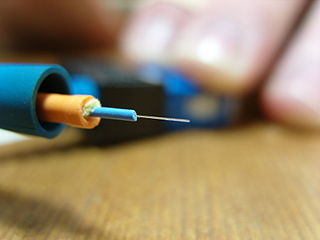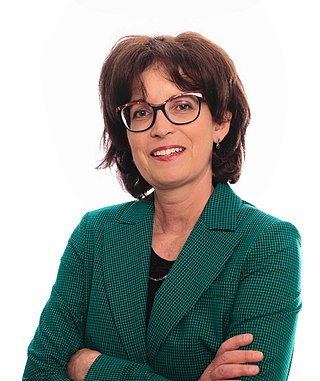
Rhodesia, officially from 1970 the Republic of Rhodesia, was an unrecognised state in Southern Africa from 1965 to 1979, equivalent in territory to modern Zimbabwe. Rhodesia was the de facto successor state to the British colony of Southern Rhodesia, which had been self-governing since achieving responsible government in 1923. A landlocked nation, Rhodesia was bordered by South Africa to the south, Bechuanaland to the southwest, Zambia to the northwest, and Mozambique to the east. From 1965 to 1979, Rhodesia was one of two independent states on the African continent governed by a white minority of European descent and culture, the other being South Africa.

Sir Charles Kao Kuen was a Chinese physicist and Nobel laureate who contributed to the development and use of fiber optics in telecommunications. In the 1960s, Kao created various methods to combine glass fibers with lasers in order to transmit digital data, which laid the groundwork for the evolution of the Internet.

The New Partnership for Africa's Development E-School Program is included as a means to provide ICT equipment such as computers and internet access to all schools in member nations within The New Partnership for Africa's Development (NEPAD) program. NEPAD parents the E-School Program and is an economic program that aims to bring economic and social development to African nations and ensure 'Africa's Renewal'. The E-School Program began with Demonstration Projects and has developed further yet remains a work in progress in many countries, facing both criticism and support.

An optical fiber connector is a device used to link optical fibers, facilitating the efficient transmission of light signals. An optical fiber connector enables quicker connection and disconnection than splicing.

Multi-mode optical fiber is a type of optical fiber mostly used for communication over short distances, such as within a building or on a campus. Multi-mode links can be used for data rates up to 100 Gbit/s. Multi-mode fiber has a fairly large core diameter that enables multiple light modes to be propagated and limits the maximum length of a transmission link because of modal dispersion. The standard G.651.1 defines the most widely used forms of multi-mode optical fiber.

The Reserve Bank of Zimbabwe is the central bank of Zimbabwe and is headquartered in the capital city Harare.

An optical fiber, or optical fibre in Commonwealth English, is a flexible glass or plastic fiber that can transmit light from one end to the other. Such fibers find wide usage in fiber-optic communications, where they permit transmission over longer distances and at higher bandwidths than electrical cables. Fibers are used instead of metal wires because signals travel along them with less loss; in addition, fibers are immune to electromagnetic interference, a problem from which metal wires suffer. Fibers are also used for illumination and imaging, and are often wrapped in bundles so they may be used to carry light into, or images out of confined spaces, as in the case of a fiberscope. Specially designed fibers are also used for a variety of other applications, such as fiber optic sensors and fiber lasers.

The individual member states of the African Union (AU) coordinate foreign policy through this agency, in addition to conducting their own international relations on a state-by-state basis. The AU represents the interests of African peoples at large in intergovernmental organizations (IGO's); for instance, it is a permanent observer at the United Nations' General Assembly.

Fiber-optic communication is a method of transmitting information from one place to another by sending pulses of infrared or visible light through an optical fiber. The light is a form of carrier wave that is modulated to carry information. Fiber is preferred over electrical cabling when high bandwidth, long distance, or immunity to electromagnetic interference is required. This type of communication can transmit voice, video, and telemetry through local area networks or across long distances.

A fiber-optic cable, also known as an optical-fiber cable, is an assembly similar to an electrical cable but containing one or more optical fibers that are used to carry light. The optical fiber elements are typically individually coated with plastic layers and contained in a protective tube suitable for the environment where the cable is used. Different types of cable are used for optical communication in different applications, for example long-distance telecommunication or providing a high-speed data connection between different parts of a building.
The African Telecommunications Union (ATU) is an organization in Africa that combines countries and mobile telecommunications providers in an attempt to dramatically increase development of the continent's information and communication technology (ICT) infrastructure.
A fiber-optic sensor is a sensor that uses optical fiber either as the sensing element, or as a means of relaying signals from a remote sensor to the electronics that process the signals. Fibers have many uses in remote sensing. Depending on the application, fiber may be used because of its small size, or because no electrical power is needed at the remote location, or because many sensors can be multiplexed along the length of a fiber by using light wavelength shift for each sensor, or by sensing the time delay as light passes along the fiber through each sensor. Time delay can be determined using a device such as an optical time-domain reflectometer and wavelength shift can be calculated using an instrument implementing optical frequency domain reflectometry.
Kingfisher International Pty Ltd is an Australian manufacturer of fiber optic test and measurement equipment, located in Mulgrave, Victoria.
NEC Laboratories America, Inc. , formerly known as NEC Research Institute, is the US-based center for NEC Corporation’s global network of corporate research laboratories. It was established in 1988 with the primary location in Princeton, New Jersey and subsequently, a second location in the San Francisco Bay Area, specifically San Jose, California. The lab is a subsidiary of the NEC Corporation of America, headquartered in Irving, Texas. Its mission is to generate significant new knowledge and create innovative solutions for society in collaboration with industry, academia, and governments. Most research results from NEC Labs America are published in the open scientific literature.

Acraea egina, the elegant acraea, is a species of butterfly in the family Nymphalidae with an extensive range in sub-Saharan Africa.
The 2019 ICC Women's Qualifier Africa was a cricket tournament that was held in Zimbabwe in May 2019. The matches in the tournament were played as Women's Twenty20 Internationals (WT20Is), with the top team progressing to both the 2019 ICC Women's World Twenty20 Qualifier and the 2021 Women's Cricket World Cup Qualifier tournaments. Uganda won the previous Africa qualifier tournament, when it was held in Windhoek in 2017.

Sophie LaRochelle is a Canada Research Chair and professor of engineering at Université Laval. She specializes in developing fiber optic components for signal-processing and data transmission in telecommunication networks.

Sierra Leone–Yugoslavia relations were historical foreign relations between Sierra Leone and now split-up Socialist Federal Republic of Yugoslavia. Two countries established formal diplomatic relations in 1961. Both countries were member states of the Non-Aligned Movement and cooperated in the United Nations in bridging the Cold War divisions. Two countries reached the peak of their diplomatic relations in cooperation on the issue of Rhodesia.












